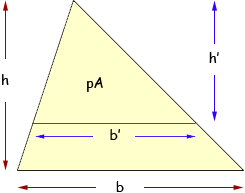 |
 |
|
Dear Math Central, I'm not concerned about height as I am wanting to break down the percentages into 60% at the bottom, 25% in the middle and 15% at the top. Thanks in advance for your help. Sincerely,
|
|
Hi Ken, I produced a diagram much like the one you sent and then I put some labels on it.
The initial triangle has base of length b and height h so the area is given by
The horizontal line cuts off a certain proportion of the area above the line. I want to call this proportion p. (I would rather work with proportions than percentages.) The horizontal cut-off line is of length b' and the triangle above this line has height h'. Thus the area of the triangle above the cut-off line is given by
Substitute A from the equation above to get
Thus
The original triangle and the triangle above the cut-off line are similar so
and hence
Finally
Thus in your example you want 15% of the area above the cut-off line so p = 0.15 and √0.15 = 0.39. Thus draw the cut-off line so that the height of the triangle above the cut-off line is 39% of the height of the original triangle. The next cut-off line is to leave 40% of the area of the original triangle above it so here p = 0.40 and √0.40 = 0.63. Thus draw the next cut-off line so that the height of the triangle above this cut-off line is 63% of the height of the original triangle. Penny |
 |
 |
 |
